Forest Resilience, Resistance, Restoration and Collaboration
By Peter Kolb, PhD — MSU Extension Forestry Specialist
If you work in the natural resources world long enough, you may notice that every several decades the academic and political worlds like to reinvent ideas and policies. With regard to forest management, the main emphasis 50 years ago was “forest productivity and sustainability” and the main goals were to increase predictable tree growth for the purpose of supplying the demands for wood fiber. Insects and diseases, always considered a problem, would be solved by science through discoveries of improved pesticides, pheromones, genetic resistance, soil nutrient supplements, and enhanced tree growth through breeding selective genetics. The transition of our northwestern climate from a 40-year cool-wet phase of the Pacific Decadal Oscillation from about 1940 until 1980, into a warm and dry trend, first surprised everyone with the big Yellowstone fire in 1988 (that has been followed by more frequent bad fire years). This event started to challenge earlier paradigms that science and more intense management could control what nature served us. As forests increasingly burned and insect outbreaks continued during the 1990s “forest health” and “new forestry” became the banner topics, along with a push for more “wilderness” and “old growth.”
At the same time, the forest products industry across the Northwest was running out of previously unharvested timber on their own vast industrial forest lands, and reduced and restricted harvests from federal lands. Historical timber harvesting had previously followed the European model of harvesting old trees that were growing at slower rates and replacing them with younger trees that exhibited fast juvenile growth rates. Germany still uses this model, which is why their forest harvest from an area comparable to Montana forests has been 12 billion board feet per year versus Montana’s 390 million board feet per year. Historically across Montana, clearcutting was widely used as an efficient means to convert old forests into younger forests. By the late 1980s, most older forests on industry lands had been harvested, and the second growth timber on previously harvested lands, although growing well, was still too young to harvest. Clearcutting, although a sound practice for certain tree species and conditions, had been overused across many landscapes and was labeled by some as abusive industrial natural resource exploitation. The term and practice of clearcutting was strongly discouraged from use within federal agencies by the late 1980s. This was a politically motivated action that removed a useful forestry practice (again under the right situation and forest condition) from the federal management toolbox for some time, and the term still causes concern among many people.
As the battle over federal forest management raged, an increasing frequency of drought years affected forests grown dense from the previous four decades of cool, wet weather (and wildfire suppression according to the majority of fire scientists) and spurred on more wildfires and insect epidemics. The forests impacted were usually the older, original (virgin) stands of trees (Image 1) with the exception of some lodgepole pine forests that had quickly regrown following extensive logging for mine timbers and railroads in the late 1800s and early 1900s. From 2007–2014 the mountain pine beetle outbreak (Image 2) killed more than half of the pines across five million acres in Montana with similar acres impacted in each surrounding state, including Idaho, Wyoming and Colorado, and 30 million acres across British Columbia. This and other beetle outbreaks added billions of tons of dead woody fuels to forests. It was the worst bark beetle outbreak recorded in modern history and some scientists even claimed “over the past millennia.”
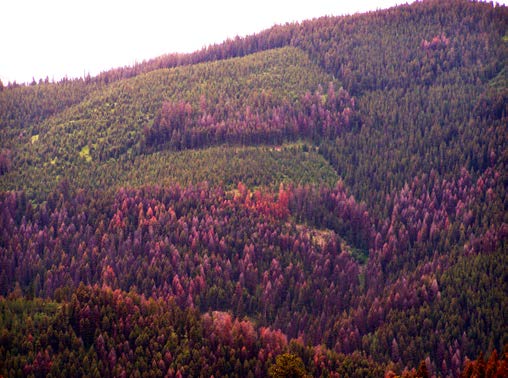
Image 1. Douglas-fir beetle outbreak 2004.
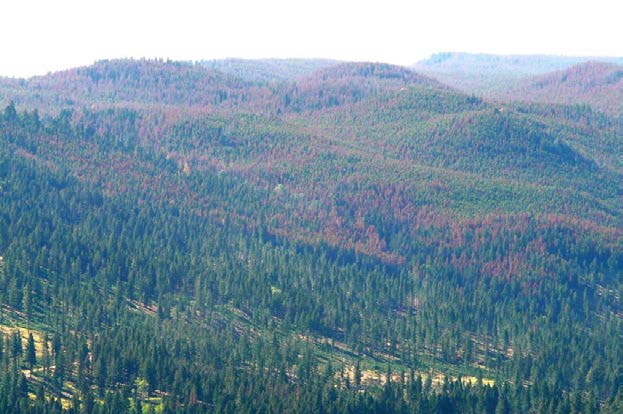
Image 2. Mountain pine beetle outbreak 2012. Thinned forest in foreground was much less impacted by beetles.
Lodgepole pine forests have a unique cyclical natural history with both bark beetles and wildfire, and its highly likely that similar or even worse outbreaks happened over the past 10,000 years of the Holocene. Paleo-ecological studies have documented multiple severe climate shifts during this time period with resulting significant changes in forest species composition. It stands to reason that major wildfire, insect and disease outbreaks occurred any time ecosystems adjusted from one climatic “normal” to another. In reference to “clearcutting,” portions of northwest Montana (like the Yaak drainage) that had experienced past clearcutting of lodgepole pine in response to the mountain pine beetle outbreak in the late 1970s and early 1980s showed the lowest impact from the more recent bark beetle outbreak (Image 3).
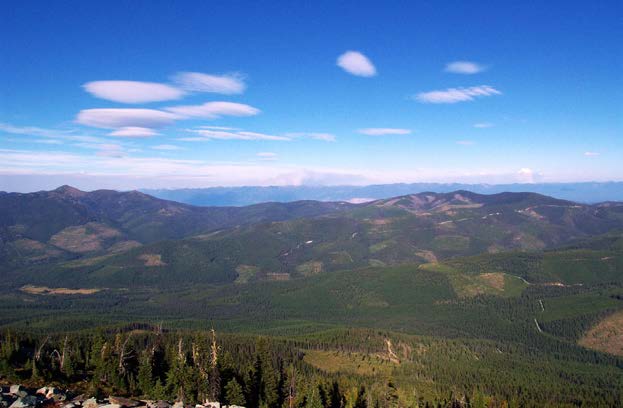
Image 3. Vista of the upper Yaak river drainage in 2012 where forests experienced only minor mountain pine beetle activity during the 2007–2014 mountain pine beetle outbreak. Previous clearcutting of lodgepole pine in the 1970s and 80s had created a mosaic of younger lodgepole pines that were not attractive to the beetles.
With wildfires and bark beetle outbreaks becoming more prevalent, the contemporary solution to the weather and climate driven mortality was to pursue a policy of “restoration” forestry, where thinning of overly dense forests seemed both biologically sound and socially acceptable. Observed bark beetle outbreak behavior from previous decades supported the hypothesis that thinned forests were less susceptible to bark beetle attacks as well. The term “restore” refers to converting forests back to some perceived historical forest composition and density. Historical forest inventory records and photographs from the late 1800s and early 1900s across different forest landscapes, before or shortly after displacement of Native Americans to reservations, were used to reconstruct a model of historical forests that had consisted of widely-spaced trees created and maintained by frequent fires. Many of the modern forest health issues, such as large, severe wildfires and insect outbreaks, are blamed on past fire suppression, extensive logging, and overgrazing by livestock that allowed forests to grow overly dense. Thus, restoring forests to conditions that existed before the western expansion of the United States is a “solution theory” prescribed by many forest ecologists and conservation efforts today. Others question if “restoring” forests to a snapshot in time from 200 years ago is based on sound science and accurate historical records. Several recent papers by noteworthy forest ecologists dispute that frequent fires had created forests of widely spaced trees across more than a fraction of the landscape and that patchy stand replacing fires actually were the more normal condition in the past. Observations of wildfire behavior and distributions of tree species and age classes across landscapes of mid to high elevation forests of Montana would support the latter hypothesis.
Within the science and economics of forest fiber production, maintaining wider tree spacing within forests ensures optimal tree growth and future fiber supplies. Thinning is widely accepted and even endorsed as an important forestry practice, not only to create more insect and wildfire-resistant and resilient forest conditions, but also with the hope that residual trees growing more quickly into larger sizes can also eventually be harvested as a resource for the struggling forest products industry. Thinning smaller diameter trees that are unsuitable for wood products remains problematic, however, because of the expense of such work, and the ability to impact enough of any forested landscape to have a significant impact on fire behavior. Most sawmills retooled and adapted to utilize small diameter tree stems decades ago, though there is a limit in the utility of how small tree stems can be used for the production of viable wood products. Smaller stems are more costly to harvest, process and convert into useable products, and they have poorer wood quality than mature stems. Longer hauling distances to the few remaining sawmills that process smaller stems is also an important economic consideration in states like Montana. The most competitive and well-developed wood products infrastructures, such as across more populated countries in Scandinavia and central Europe, can utilize every portion of a tree, even converting excess and unmerchantable woody debris into wood-based chemicals and energy, though the latter is only feasible where traditional energy sources are expensive (Germany electricity cogeneration facilities are profitable because the average kilowatt-hour there for electricity costs $0.42 per kWh compared to Montana’s $0.12 per kWh).
According to ecological restoration sciences and many conservation groups, forest thinning can emulate what the historical Native American use of fire created in lower elevation forests across Montana, as well as set the stage for fire to be reintroduced to landscapes as the preferred “natural” alternative to future mechanical harvesting. A future of letting wildfires, or purposely set spring and fall prescribed fires, burn across landscapes to maintain or restore historic forest ecosystems of open forests with widely spaced trees has become the target “restoration” model for many select federally-owned landscapes, especially those around and near communities. Although the concept of letting fires perform their historical natural role seems attractive, the ability to do this in a safe and cost-effective manner across larger landscapes accrues enormous costs, with significant risks both from the fire control perspective as well as if ecologically sound results will truly be met.
The past 100 years of forest management should be viewed as part of the learning process for both forest stand and landscape ecological process, as well as models for economic sustainability. Labeling them as the “good ole days” or “exploitative ravaging of nature” ignores historical circumstances as well as the needs and living conditions of the past. Almost every past forestry-related action was supported by the scientific knowledge and the social and economic beliefs of the time. Within the forestry profession, sustainable tree growth across federal, state and private lands was a main objective of forest managers, and for the most part a goal well met based on the current condition across old harvest units. Almost all previously harvested forest lands today support good tree growth, though mostly in ages 100 years or less. Sometimes these areas support more simplified assemblages of tree species that were promoted because of their growth potential for future harvests, or because only certain tree species could survive being planted in the fickle and unforgiving climate of Montana. Much of the 1910 Great Burn that destroyed trees on over three million acres along the Montana/Idaho border was replanted to tree seedlings in the following decades in what might be considered one of the greatest conservation efforts ever. The wood products industry has always had a vested interest in maintaining productive forested landscapes, and was (and is) seeking solutions to best maintain forests in a world increasingly dominated by ideological discussions of the future climate, historical pre-European forest conditions, carbon sequestration, and endangered species.
In the meantime, forest lands impacted by wildfires over the past four decades are increasingly defined by large areas converted from forest to brush-fields and grasslands (Image 4). Contemporary wildfires have become not only a major threat to rural and municipal landowners and infrastructure, and a huge cost to control, they are also dramatically altering the role and function of forested landscapes. We have, in essence, moved back to the conditions of the 1920s when wildfires and dustbowls were also a climate-driven process. Forest insects such as bark beetles and defoliators including spruce budworm and tussock moth also remain problematic. This may be good in certain circumstances where forest encroachment onto prairie lands is an ecological and economic problem, but also bad where tree-covered landscapes maintain critical winter snowpacks, primary watersheds, wildlife habitat, potential wood fiber, and aesthetic appeal.
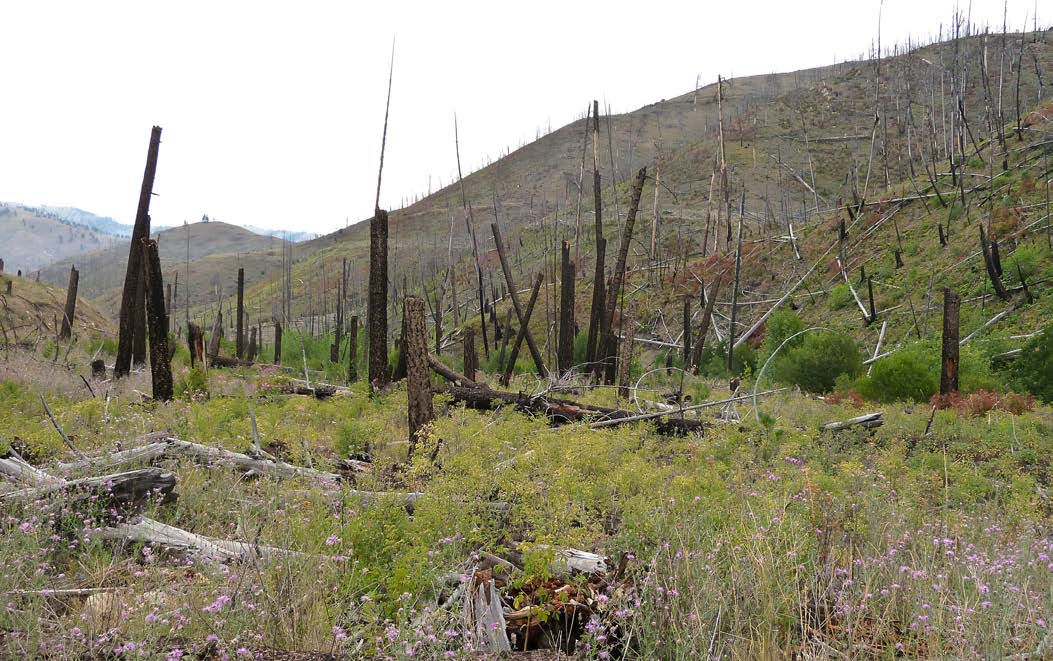
Image 4. Many of the 2000 Bitterroot fire areas will take a century or more to recover to forest, if ever. This photo was taken at Laird Creek 13 years after the fire.
When reviewing forest management history, especially across Montana, it is important to note that every past management practice has added to our overall knowledge of how our native forests function and can recover from disturbances. More knowledge is good, but also makes decision making more complicated, in part because nature is complicated as are social needs, both real and imagined. Given the tortuous trail of forest management practices and policy across Montana, are we finally to the point where we have enough knowledge and decision making processes (politics) to develop management objectives and practices that reflect true conservation (protection and use) of the unique forest ecosystems of the Northern Rockies?
The terms in the title of this article are often heard in contemporary discussions about forests across the world, especially in the context of global climate change, the role that forests play in sequestering atmospheric carbon, and the protection of ecosystem services (water, wildlife, wood products, recreation). Across the western United States, forest resilience and resistance are commonly used today to describe some forest condition that implies a forest that can survive a severe wildfire, insect outbreak or extreme weather event such as drought. In broad ecological terms, resistance refers to a forest’s ability to persist or withstand some disturbance, whereas resilience is the ability of the forest to recover following a disturbance. However, there are many important qualifiers for using these terms that include the time frame a forest practice remains effective, increasing resistance or resilience (5, 50, 100, or 500 years?), and the effective scale needed (1 to 10,000 acres?) to provide a useful impact. Providing guidelines that a landowner or a national forest might consider will vary tremendously, as well as how the largest landowners might collaborate with smaller forest ownerships surrounding them.
Forest types and tree species
Every forested type, determined across landscapes by the ability of different tree species to survive and reproduce is shown in Figure 1, and has different natural histories that involve the role of multiple disturbances at varying scales. The warmest and driest zones are found in low elevations across south and west mountain exposures, and many eastern Montana ponderosa pine forests. For western Montana, this zone is where Indigenous people’s burning practices resulted in frequent fires and the development of groves of large, old ponderosa pines (Image 5).
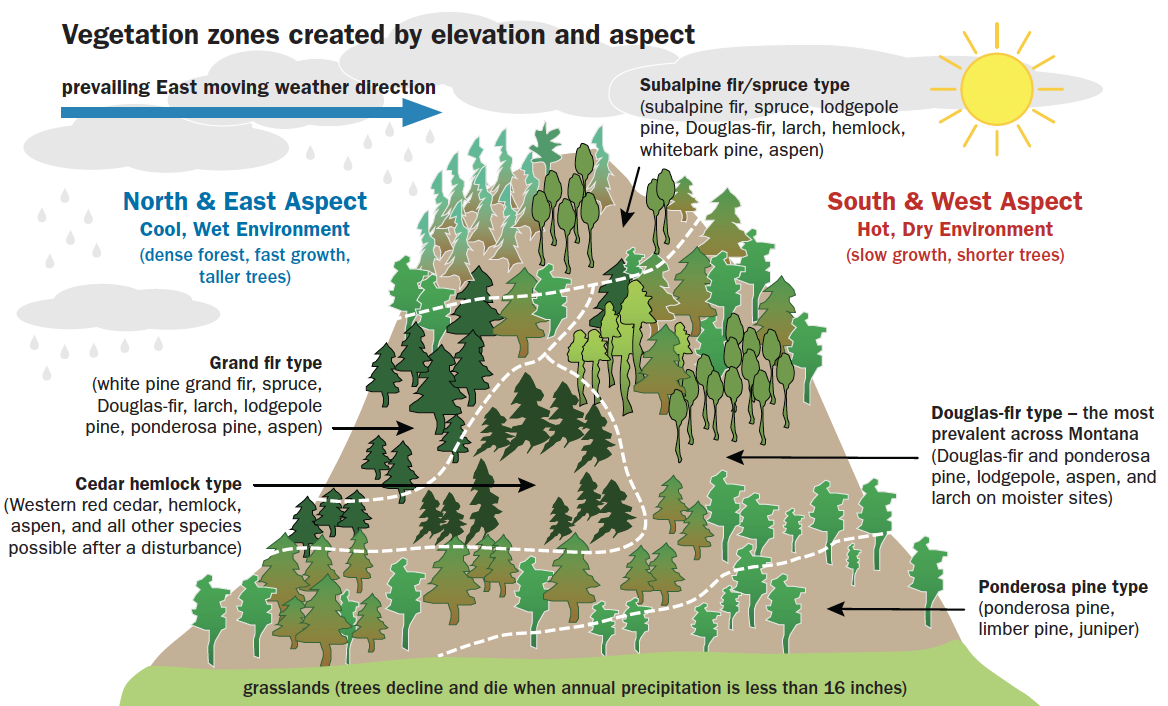
Figure 1. Major forest types across Montana.
For eastern Montana where wind and drought are common, large wind-driven fires were the normal disturbance, resulting in a patchy mosaic of trees of various ages. Giant old trees were restricted to rocky cliffs and microsites that excluded the effects of raging crown fires that raced across landscapes. Native American influences on these forests also varied across the last 10,000 years of the Holocene as tribal entities moved and changed across the landscape, but can be considered an overall major influence on the development of forests across Montana. The introduction of horses in the early 1700s strongly influenced tribal cultures and their impact on landscapes. Insects and diseases also played roles, probably in minor patches when frequent fire was prevalent, and across larger landscapes when climatic fluctuations occurred such as oscillations between cool-wet and warm-dry phases of the Pacific Decadal Oscillation.
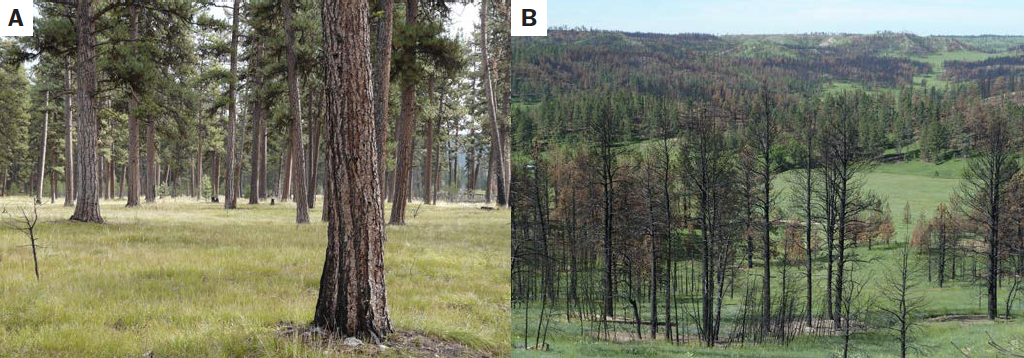
Image 5. Modern-day results can be seen of the historical role of frequent fires across western ponderosa pine ecosystems (A) versus wind driven fires across eastern Montana (B).
The Douglas-fir forest type is the largest forest ecotype found across Montana and perhaps the most diverse and complicated. At the dry end of this forest type, that is often at lower elevations or southern aspects across the landscape, frequent fires maintained ponderosa pine as the dominant tree species. Since Douglas-fir is more shade tolerant than ponderosa pine, the battle between ponderosa pine and Douglas-fir dominance on any site was determined by the periodic occurrence of fire, either from the frequency of lighting or changes in use of fire by Native Americans. Any absence of fire in this ecosystem that lasts longer than 5–20 years allows for the potential of rapid invasion of Douglas-fir into the understory of mature ponderosa pine (Image 6). This same struggle remains an issue across the Douglas-fir ecotype to this day. Managing for more open stands of older ponderosa pine requires keeping Douglas-fir regeneration out by either mechanical means or the use of fire.
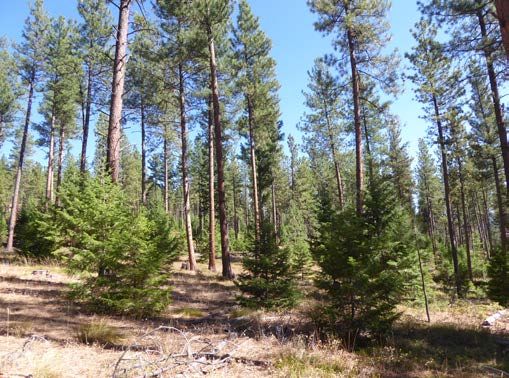
Image 6. Dry end of Douglas-fir ecotype with fire-maintained ponderosa pine overstory and understory Douglas-fir invasion during lack of fire.
Across the wetter and cooler end of the Douglas-fir ecotype, fire history studies indicate less of a frequent fire regime, and more of a 20–200 year fire interval where fire created a patchy landscape (Image 7). The role of western larch and lodgepole pine is important across this mosaic, where both species require patches of trees to be killed by fire for their shade intolerant seedlings to have a competitive foothold. Depending on the particular topography and position on that landscape, fire-killed patches of one-tenth of an acre to 1000+ acres can foster the development of stands of larch and lodgepole pine. Larch has a narrower range of conditions where it can survive which is why it only occurs across northwest Montana. Where larch is absent, lodgepole pine is the main colonizer after a severe wildfire. Lodgepole pine patch size often indicates the magnitude of past fires across landscapes.
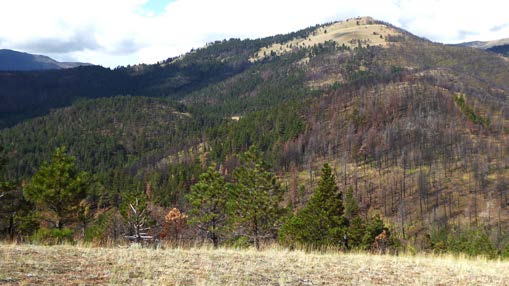
Image 7. Across the wetter end of the Douglas-fir forest ecotype, fires were less frequent and tended to burn in a more patchy mosaic.
Yellowstone National Park is an example where infrequent but expansive wildfires created one of the largest continuous lodgepole pine forests found across the Northwest. The size of any fire-created patch is determined by the weather when the fire burned, in combination with the complexity of the topography, occurrence of streams and water abundant seeps, previous fire history and resulting tree species assemblages, and an element of luck. This makes the “mixed severity fire” zone very complicated to reproduce on a landscape within any particular historical context. Across Montana we are fortunate that many landscapes still present ample evidence of the historical pattern of disturbances by the tree species that colonized certain areas of landscapes, and their ages (Image 8). However, both 40 years of cool, wet weather and fire suppression has allowed most shade tolerant tree species to expand into previous fire-maintained and fire-created patches, resulting in a greater probability of severe and expansive wildfires. This in turn allows current wildfires to burn through previous fire patches with diverse species and age classes and simplify these ecosystems into lodgepole-pine-dominated landscapes as it is the only species that can regenerate after these kinds of fires (Image 9). Thus, this wetter end of the Douglas-fir ecotype is at great risk of dramatically changing from a patchy, mixed-species forest, to a landscape with fire-created monocultures of lodgepole pine forest.
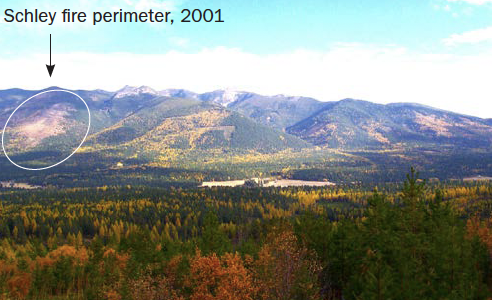
Image 8. Bright yellow needles of western larch patches indicate where past fires occurred, a pattern retained by the more recent 2001 Schley fire.
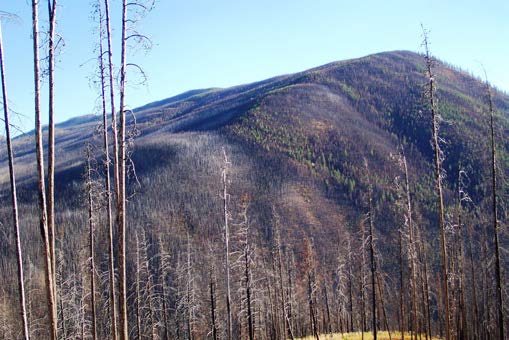
Image 9. Severe landscape fire that killed the majority of the tree species and their seed source and that will result in a larger monoculture of lodgepole pine.
Wetter forest ecotypes including subalpine fir, grand fir and western red cedar also fall into the “mixed severity” wildfire category, though often they historically supported less frequent and larger stand-replacing fires. The area of the 1910 Great Burn on the Montana/Idaho state line falls into this category, though much of this area might have supported a mosaic of smaller wildfire-created patches from the previous several centuries that were erased by the expansive and severe fire of 1910. Old patches of fire-created snags are still very visible across much of this burn area, indicating a past mosaic comprised of complex stands of older and younger trees. These wetter forests also supported western white pine, that may have been a very important pioneer tree species, along with western larch and lodgepole pine. Western white pine exhibits mildly fire-resistant cones and rapid juvenile growth that would have allowed it to dominate fire-created patches across northern Idaho and the north and east slopes across northwest Montana. Both extensive logging of this highly valued wood species and the introduced white pine blister rust very much changed the role of this once iconic species. Reintroducing white pine that has been genetically selected for blister rust resistance into burned or harvested landscapes is part of the restoration strategy for this species. Pockets of locally native western white pine can still be found in many locations of western Montana and northern Idaho (Image 10).
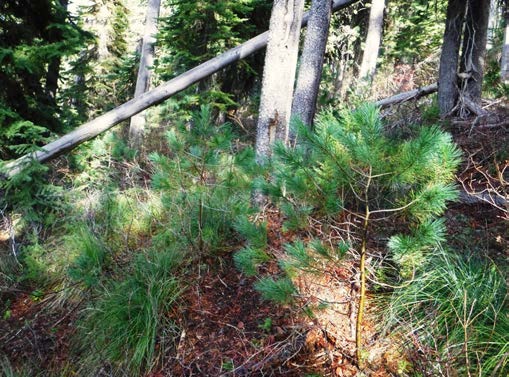
Image 10. Pockets of naturally occurring western white pine can be found in small openings created by fire, harvesting or bark beetles. Whether or not these are naturally selected blister-rust-resistant trees is unknown.
Lodgepole pine with its serotinous cones, and western larch with its thick bark, tall crowns and great tree longevity (the Girard larch grove near Seeley lake contains trees that may be 1000 years old), are currently the most predominant species adapted to survive large, severe fires across wetter forest ecotypes. Lodgepole pine has seed protected in serotinous cones that open after a fire, whereas western larch develops into giant, fire-resistant trees that produce prolific light seeds that can float in a breeze for many miles, allowing this species to colonize disturbed areas across great distances. Higher elevation sites tend to be favored by lodgepole pine as thin soils and periodic summer drought, especially on high elevation south aspects, allow for more frequent (100-200 years) wildfires to kill other tree species (Image 11).
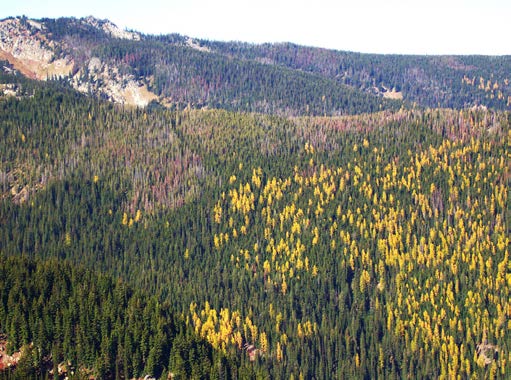
Image 11. Natural recovery of tree species following the fires of 1910 favored lodgepole pine at higher elevations and western larch (yellow fall foliage) at lower elevations and N and East slopes. The 100 year-old lodgepole pine in this picture is being killed by mountain pine beetle.
Western larch has the advantage at wetter lower-to-mid-elevation forests where wildfires may only occur every 10-500+ years. The longevity of larch and the ability of big old trees to survive both frequent fires that may have been set along low elevation travel routes of Indigenous people, and high severity infrequent fires on inaccessible mountain slopes gives this tree species an important role where wildfire could occur at highly variable intervals. Larch has historically also been a highly valued timber species, both for its wood quality and for its tendency to grow very tall, uniform stems that make sawmilling more profitable. Its common occurrence on accessible mountain terrain has probably resulted in a disproportionate harvesting of large, old trees of this species. Fortunately, larch needs disturbances that result in full sunlight and disturbed soils to regenerate, and many areas that supported either stand-replacing wildfires or intense logging across the landscape have regenerated well with dense western larch stands (Image 12).
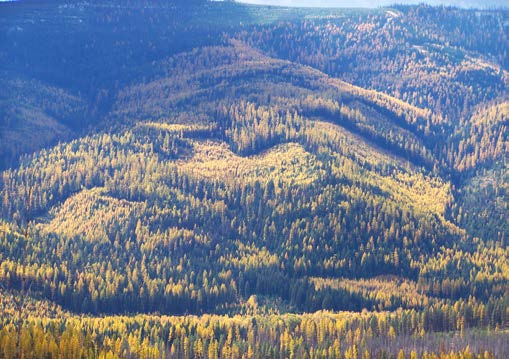
Image 12. Past clearcuts were rapidly colonized by western larch seedlings. Larch responds well to larger, disturbed areas, which is part of its historical adaptation to wildfires.
Restoration practices for resilience
For every forest ecotype found across the Northern Rockies, there are multiple pathways for tree species to persist and regenerate, where over the millennia genetic selection has given every tree species unique survival strategies. A diagram of one the simpler two-species forest ecotypes is shown in Figure 2. A stand of ponderosa pine occurring in a Douglas-fir ecotype might have a tree thinning treatment completed to space trees more widely and remove an understory of dense Doulas-fir seedlings. This reduces competition for limited soil water, and thus drought stress, which in turn makes the residual stand more resistant to bark beetle outbreaks and wildfire damage.
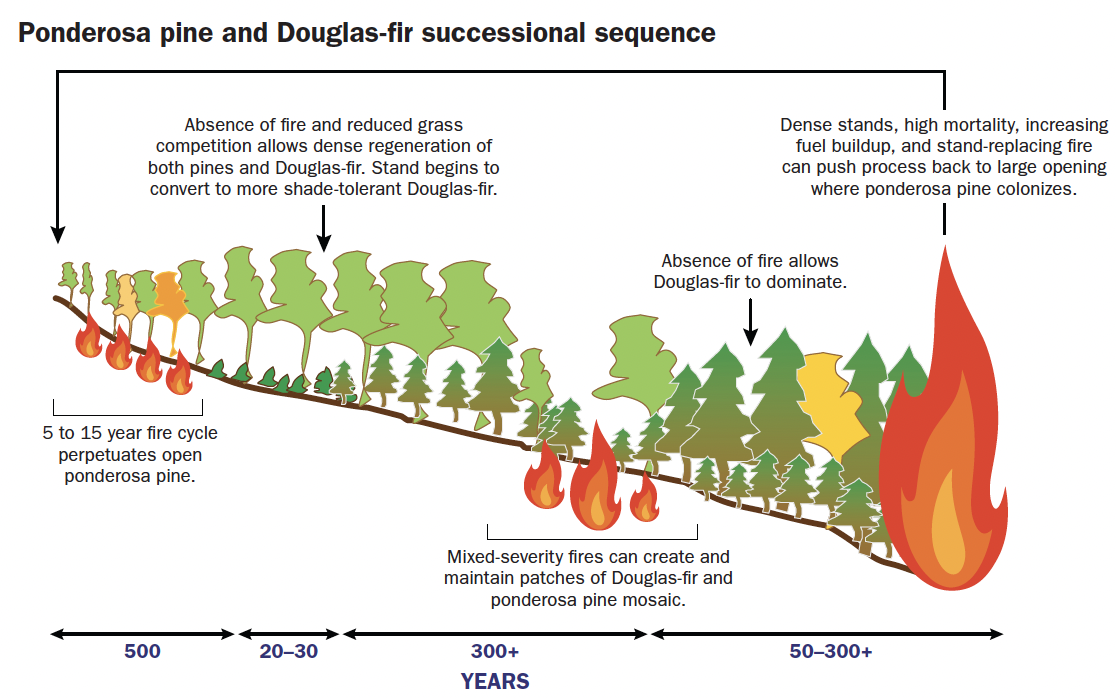
Figure 2. A time scale diagram of how a disturbed site first colonized by ponderosa pine might be maintained by frequent fires, and over time can convert to a mixed species, where a mixed-severity fire or stand-replacing fire can occur. Any landscape covered by this single forest ecotype can consist of many patches of any one of these species and age structures, which gives the forest greater resilience to a variety of disturbances. Age designation at the bottom of the diagram are estimates of how long any one of these stages may persist before tree age or disturbances force a change.
Such treatments, however, do not last forever and are limited in how long insect and fire resistance is maintained. This can vary from a few years to multiple decades depending on the site and weather. Much depends on the width of tree spacing applied, the growth rate and age of residual trees, the proximity of seed producing Douglas-fir (that can commonly disperse seeds for 200 yards), and the soils capacity to absorb and store water that influences tree growth and longevity.
Where any treatment occurs on the landscape, the size and location of the treatment plays an important role. Although the stand may have increased resistance to beetles and fire, its individual resilience and impact it has on landscape resilience is very much determined by the position and size of the treated area. Smaller “resistant” areas can be overwhelmed by surrounding, intense fire behavior or bark beetle epidemics. The larger the “patch” treated, the more effective it can be. Across some landscapes where high intensity fire burned, patches as small as three acres survived the fire effects (Image 13). If forest treatments are more frequently and strategically distributed across a landscape, this increases stand resistance (by manipulating tree species, age classes and density) and forest resilience.
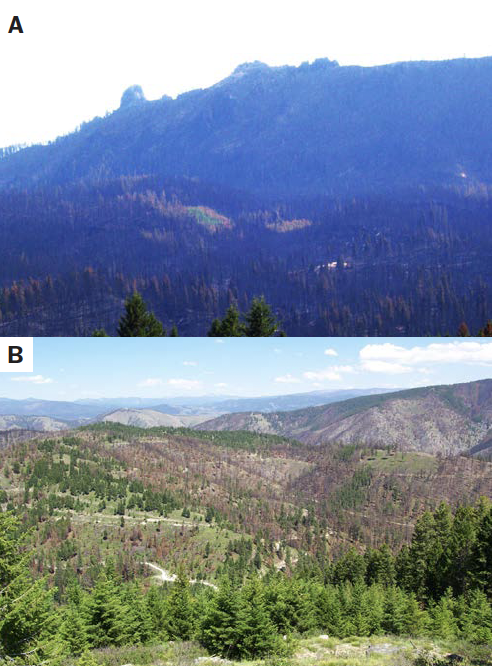
Image 13. A large, high-intensity wildfire (Fridley fire in 2002) burned across 25,000 acres and skipped over several small patches (A) of younger and more resistant trees created by harvesting in a stand dominated by lodgepole pine with some spruce and Douglas-fir. This three-acre patch will provide multiple species’ seeds to recolonize the landscape, providing the ecotype with some resilience. (B) Across a different fire (2000, Valley complex) a landscape with multiple treatments created greater stand diversity that had a greater effect on creating ecotype resilience.
For optimal forest resilience across landscapes, it is important that every phase of an ecotype’s ecological cycle is represented. The ponderosa pine and Douglas-fir ecotype in Figure 2 is relatively simple. However, the more water that a site across the Northern Rockies has, the more tree species can exist, and the more combinations of fire, insect and disease effects there can be. Each tree species and age combination may have different birds, rodents, other wildlife, insects, fungi and even bacteria associated with it, and even dependent on it, which is why it is important that multiple combinations of potential forest attributes for each ecotype are maintained across landscapes. This philosophy has previously been labeled as “the coarse filter approach,” which implies that managing for large-scale historical forest attributes will automatically provide habitat for finer-scale attributes such as individual endangered species or species of concern.
The Northern Rockies are defined by a highly wrinkly topography that has allowed isolated populations of species with unique genetics to develop. These are referred to as “metapopulations.” How many and specialized such metapopulations are is unknown for most species, but the genetic diversity across this wrinkly landscape is also part of the forest resilience equation. As climatic shifts occur, some currently localized genetics might exhibit greater adaptability than others, which may be important for that species’ continued survival. Thus, genetic resilience is important for overall species and thereby, ecosystem resilience. Forest and ecosystem conservation and management actions need to be site-sensitive and specific. To create this kind of management requires site-specific inventories and knowledge that can only be achieved through local collaboration and planning.
Wildfires, insects and disease outbreaks will always have strong impacts across our forests. In some cases, they may have a positive effect by enhancing diverse forest conditions, in others they may have a simplifying effect, eliminating all but a few species. Relying solely on nature is a big gamble. Working with and understanding natural processes with appropriate use of forest management practices, such as tree harvesting, can be very effective for increasing resilience across landscapes by reducing the magnitude of disturbances processes. This same philosophy applies to intensively-managed forest landscapes that would benefit from restoration of some tree species diversity and older age classes of trees.
Central Europe has relied for centuries on Norway spruce because of its exceptional growth rates, useful wood and aesthetic appeal. It has historically provided 80 percent of the wood product for portions of Germany such as in Bavaria and Thuringia. Three years of drought have allowed the spruce engraver bark beetle to reach historic epidemic levels and devastated millions of acres of forest (Image 14). The solution that scientists and foresters there have found is to manage for a greater mosaic of tree species and age classes across the landscapes.
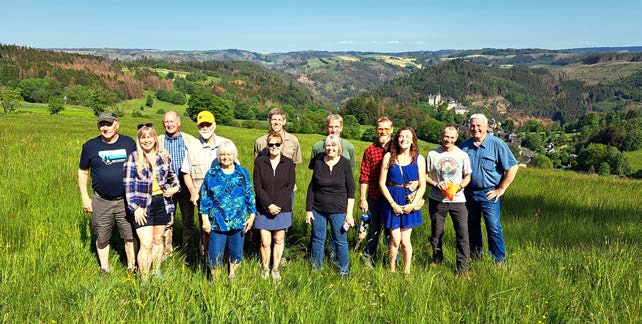
Image 14. The 2023 German forest study tour with a ninth-century castle in the background and millions of acres of dying Norway spruce. This is due to heavy reliance on intensive management to grow one optimal tree species. Three years of drought and an outbreak of spruce engraver beetle is devastating forests there.
Managing for forest resilience requires detailed analysis of a landscape and a strategic plan for that landscape. That might include managing landscape wildfires when weather and resources permit (Image 15), using harvesting to create a viable mosaic (Image 16), or a combination of both. As has been pointed out by both forest preservationists and commercial forest managers, thinning alone is not the solution for current wildfire, pest and pathogen issues. It is a useful tool that can increase individual stand resistance to fires and pests, but needs to be combined with other practices that allow establishment of sun-loving species and for diversifying the ages of the different stands of tree species across the landscape. Historically, Northern Rockies ecosystems survived past climate driven calamities because they consisted of a patchy forest landscape. In certain areas such as the Yellowstone ecosystem and wetter northwest Montana, some patches were thousands of acres in size. In other areas the wrinkly topography created a mosaic of patches ranging from one-tenth of an acre to 1000+ acres. For private landowners, managing for multiple patches of species and ages across ten acres is not unrealistic depending on the forest type owned. For larger-acreage landowners, smaller and multiple larger patches will increase overall forest resilience, as well as sustainable economic returns. In both scenarios, knowing what neighbors are doing and if possible, coordinating with them, is an essential component to promote both stand resistance and forest resilience.
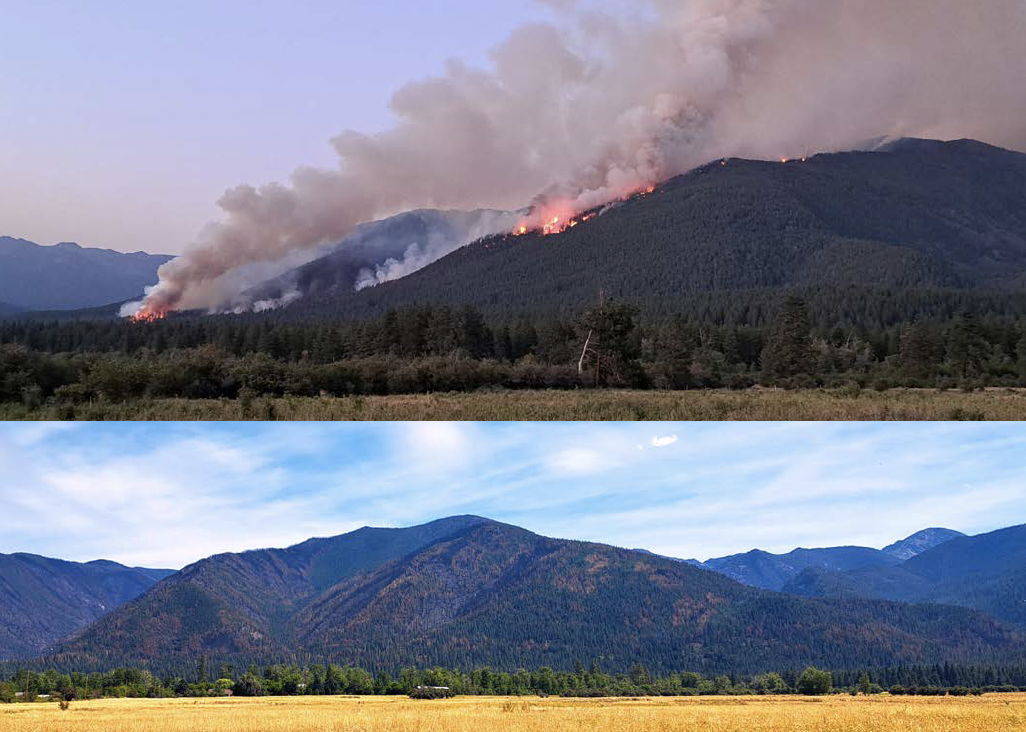
Image 15. The 2023 Big Knife fire burned under the right circumstances and was “shepherded” across the landscape through extensive helicopter and airtanker use. The two months-after result was a healthy mosaic of fire effects. Planned forest harvests could create a similar mosaic.
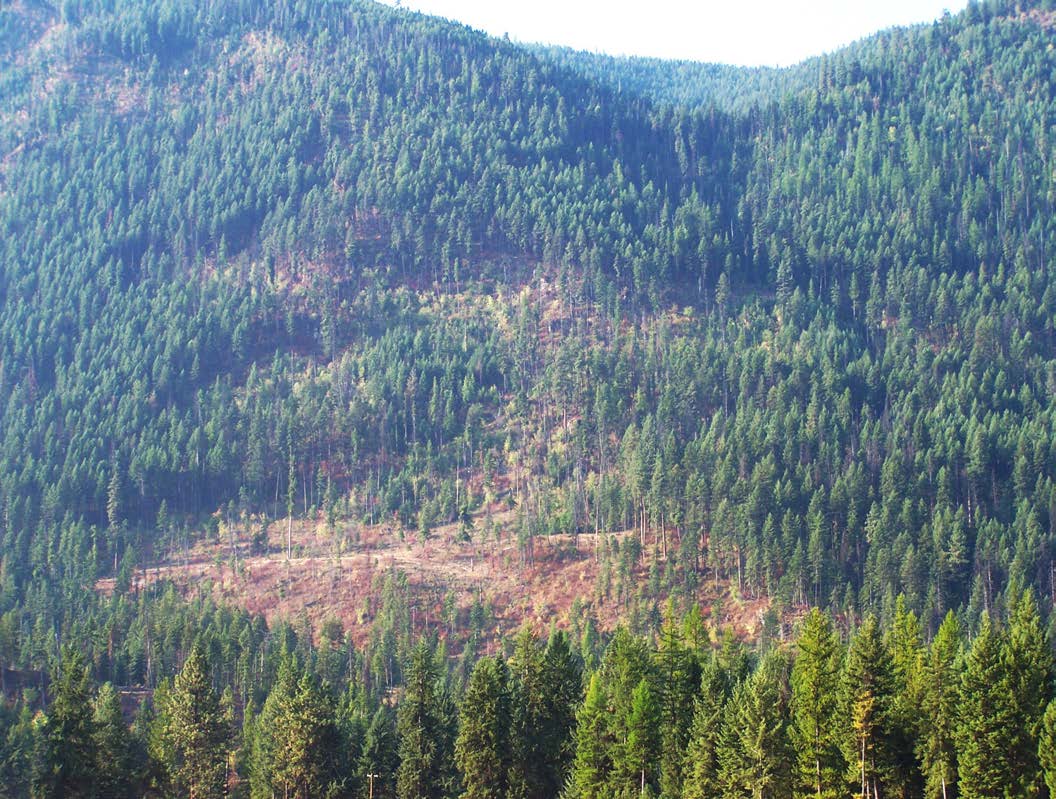
Image 16. A harvest across a landscape that created a patchy, resilient environment emulates what a wildfire might create under the best of circumstances and typically provides a monetary return to the landowner. Harvesting combined with fire (small pile burning on many locations can qualify) provides a useful compromise of control and desirable impacts such as microsite preparation, nutrient cycling and soil charcoal addition.
